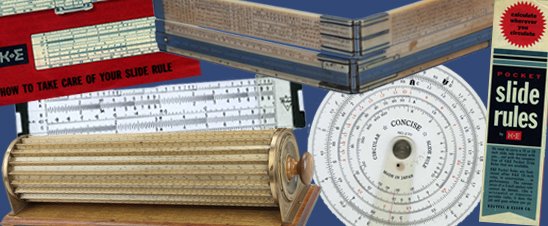This ten-inch double-sided mahogany rule is fully covered with white celluloid. On one side, there are L, LL1, DF, D, LL3, and LL2 scales on the base and CF, CIF, CI, and C scales on the slide. The top of the base is marked in red: KEUFFEL & ESSER CO. N.Y.; PATS.
- Description
-
This ten-inch double-sided mahogany rule is fully covered with white celluloid. On one side, there are L, LL1, DF, D, LL3, and LL2 scales on the base and CF, CIF, CI, and C scales on the slide. The top of the base is marked in red: KEUFFEL & ESSER CO. N.Y.; PATS. RE.20,984 1,930,852 2,168,056 2,170,144 PAT. PEND.; MADE IN U.S.A. The right end of the slide is marked with the model number: < 4080-3 >. On the other side, there are LL0, LL00, A, D, DI, and K scales on the base and B, T, ST, and S scales on the slide. The left end of the slide and the front left corner of the base are marked with a serial number: 728903. The indicator is glass with plastic edges held together with metal screws. A piece is missing from the top edge; if it were whole, it would read: KEUFFEL & ESSER CO. N.Y. The bottom edge is marked: PATENT 2,086,502.
-
In images of the object, the slide is upside down.
-
The rule fits into a sewn orange leather case. The flap is marked: K & E (/) LOG LOG DUPLEX (/) TRADE TRIG MARK (/) 4080-3S. The S refers to the sewed leather case. A paper table of equivalences was once attached to the case, but most of it has been torn away. The remaining portions resemble the charts on K&E simplex slide rules, such as 1984.1068.01. The back of the case has a metal ring, presumably to fit around a belt loop, and is marked: R. L. HUFFMAN.
-
K&E used this combination of scales on this model from 1939 to 1947. The serial number on this example is consistent with a date earlier in this time frame. In 1947, it sold for $18.00. Included in the acquisition is a manual by William E. Breckenridge, The Log Log Duplex Slide Rule (1939). Compare this rule to 2007.0181.01.
-
Robert L. Huffman owned this instrument. It seems likely that he used it as a college student. He received a Bachelor of Mechanical Engineering degree from the University of Minnesota in 1941. Huffman went on to work for Automatic Electric Company of Chicago and then, from 1945, for General Telephone Laboratories.
-
References: Alfred W. Keuffel, "Slide Rule" (U.S. Patent RE20,984 reissued Janaury 24, 1939); Alfred W. Keuffel, "Slide Rule" (U.S. Patent 1,930,852 issued October 17, 1933); Adolf W. Keuffel, "Runner for Slide Rules" (U.S. Patent 2,086,502 issued July 6, 1937); Carl M. Bernegau, "Slide Rule" (U.S. Patent 2,168,056 issued August 1, 1939); Lyman M. Kells, Willis F. Kern, and James R. Bland, "Slide Rule" (U.S. Patent 2,170,144 issued August 22, 1939); Clark McCoy, "Collection of Pages from K&E Catalogs for the 4081-3 Family of Slide Rules: 4080-3 & 4081-3 Family Groups," http://www.mccoys-kecatalogs.com/KEModels/ke4081-3family.htm; The Automatic Electric Technical Journal 1, no. 2 (July 1948): front matter.
- Location
-
Currently not on view
- date made
-
1939-1947
- maker
-
Keuffel & Esser Co.
- ID Number
-
1992.0437.01
- catalog number
-
1992.0437.01
- accession number
-
1992.0437
